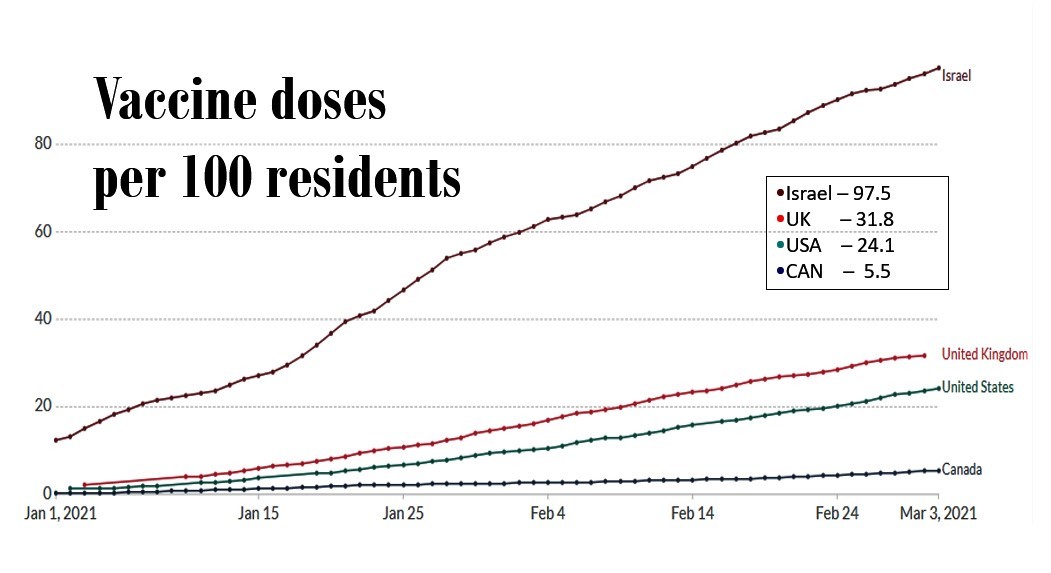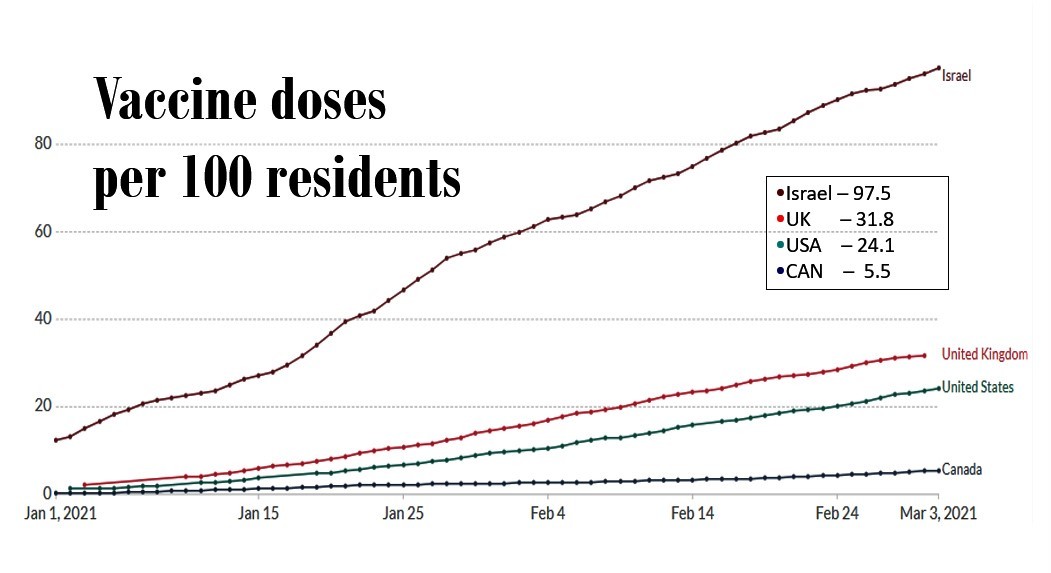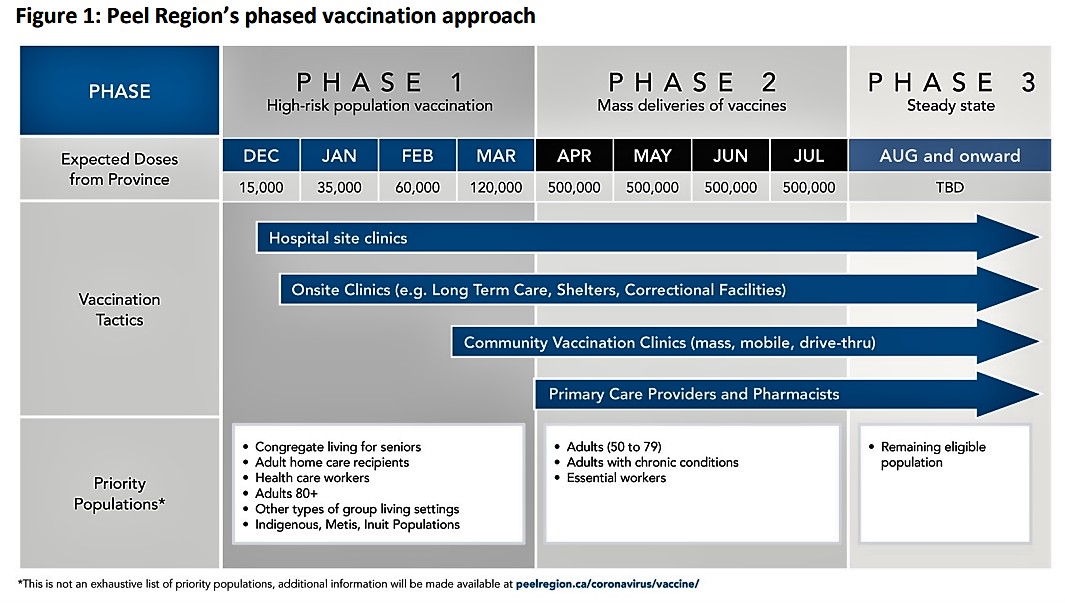
Vaccine envy growing for many Canadians as competition disrupts global supply chains
Early this week Canadians were told the first shipment of the recently approved AstraZeneca COVID-19 vaccine was in transit and was supposed to arrive Wednesday according to Procurement Minister Anita Anand, who said a total of 944,600 new vaccine doses would be here this week.
The new vaccine is supposed to arrive from India, where 500,000 doses of the AstraZeneca product were manufactured for Canada by the Serum Institute of India, while another 444,600 doses of the Pfizer-BioNTech vaccine were also expected.
“This week, we are on track to see approximately 945,000 doses of vaccines arriving in Canada,” Anand said Tuesday. “Thus, almost a million doses will be delivered into this country this week alone, and next week we are set to receive more than 900,000 doses of vaccines,” she added.
It was welcome news in a country that has fallen way behind many others in the race to secure and administer vaccines.
According to the Our World In Data global vaccination dashboard, which is housed by the University of Oxford’s Oxford Martin Programme on Global Development, Canada was in the 55th spot as of March 3, for vaccine doses administered per 100 residents, sitting at 5.5. By comparison, Israel, near the top of the list, had administered 97.5 doses for every 100 residents. The UK was at 31.8 and the U.S. was at 24.1 doses for every 100 residents.

Making things even more worrisome is the news that supply chains once again appear to be uncertain, after Canada was deeply impacted over the last six weeks by manufacturing shortages and severe European Union policies that slowed vaccine exports early in the year.
Reuters reported Thursday that the EU is now planning to extend strict COVID-19 vaccine export measures to the end of June, as a shipment of AstraZeneca doses that was supposed to be sent to Australia has been blocked.
Canada, without its own domestic vaccine manufacturing sector, relies on other countries, and many of them are ensuring there is enough supply for residents where the manufacturing is done, before large scale exports are prioritized.
The EU policy forces manufacturers to get approval before exporting doses, and unless commitments to EU nations are met, shipments to other countries can be denied.
The scheme was set up in January when some suppliers informed the EU that shipments it was expecting could not be made, likely because doses were sent elsewhere. Countries around the world, including Canada, have been forced to compete with each other for limited vaccine supplies, and we have clearly not done a very good job in the open market, despite assurances late last year by Prime Minister Justin Trudeau and his Liberal cabinet ministers that Canada would have an ample supply of vaccines from the beginning.
Now, out of desperation, other approaches are being adopted. Canada's deputy chief public health officer Dr. Howard Njoo said this week that provinces have agreed to delay second doses, to get more residents vaccinated.
Ontario, along with the rest of the provinces, has signalled it will follow guidance this week by the National Advisory Committee on Immunization to hold off administration of second doses by up to four months in order to speed up inoculations and help avoid a third wave of COVID-19.
The recommendation says one dose is very effective and the move will help reach herd immunity in the country much faster.
In hard-hit regions like Peel, which has already prepared its vaccine roll-out plan, the one thing missing is enough shots to get the region’s 1.5 million residents protected. Peel Public Health has set lofty goals, such as getting 75 percent of the population inoculated and ramping up vaccinations to 500,000 a month by April.

The Region of Peel's vaccine roll-out plan
That might not be achievable if supply chains continue to pose problems. For the month of February, Peel was anticipating 60,000 doses from the Province. As of February 22, 45,300 doses had been administered throughout the region in total, including over 15,500 doses in long-term care and retirement homes.
As of February 25, Ontario had administered a total of 621,960 vaccine doses, meaning Peel accounted for 7.3 percent of the total vaccines Ontario had received (Peel has about 10.3 percent of the province’s population). Hamilton and Halton had administered a total of 32,925 as of February 24 and 23,934 as of February 19, respectively.
This means that by the last week of February, Peel had received fewer doses per capita than two regions with a far lower infection rate.
It doesn’t bode well for residents who have endured two waves of neglect, with some of the lowest testing rates and highest infection rates in Ontario.
Now, as questions mount about when vaccines will arrive to adequately inoculate enough of Peel’s population so that widespread community protection can be achieved, Ottawa and Queen’s Park are struggling to get vaccines to those in Brampton and Mississauga waiting to finally get a break during this protracted pandemic.
Last week, Peel regional councillors unanimously passed a motion to take the concerns of constituents to Premier Doug Ford, calling on the Province to adjust its plan for prioritization of vaccine supply, eligibility and distribution to “enable those areas of the province in prolonged shutdown with high rates of transmission of COVID-19, including Peel, to accelerate the vaccinations of their populations.”
With Peel’s prolonged stay-at-home-order set to be lifted after March 8, Dr. Lawrence Loh, the region’s top public health official has sounded nervous about the possible effects of loosened restrictions. He has been warning elected officials and the public that irresponsible behaviour will lead to another shutdown, meanwhile increased spread of the novel coronavirus variants has him concerned that another significant spike could be seen.
He already offered ominous numbers this week for Brampton, sharing data that show test positivity and infection incidence rates in the city are already on the rise, likely as a result of surrounding regions that had the stay-at-home-order lifted a few weeks ago.
When Peel and Toronto were kept under the stay-at-home-order two weeks ago, Health Minister Christine Elliott said, "These are difficult but necessary decisions, in order to protect against COVID-19 variants and maintain the progress we have all made together. Until vaccines are widely available, we continue to urge all Ontarians to follow public health advice and measures, and stay home, stay safe, and save lives."
For Peel, with the variants now spreading and no clear picture of when enough vaccines will arrive, residents are left, once again, wondering if history will repeat itself.
Email: [email protected]
Twitter: @JoeljWittnebel
COVID-19 is impacting all Canadians. At a time when vital public information is needed by everyone, The Pointer has taken down our paywall on all stories relating to the pandemic and those of public interest to ensure every resident of Brampton and Mississauga has access to the facts. For those who are able, we encourage you to consider a subscription. This will help us report on important public interest issues the community needs to know about now more than ever. You can register for a 30-day free trial HERE. Thereafter, The Pointer will charge $10 a month and you can cancel any time right on the website. Thank you.
Submit a correction about this story


